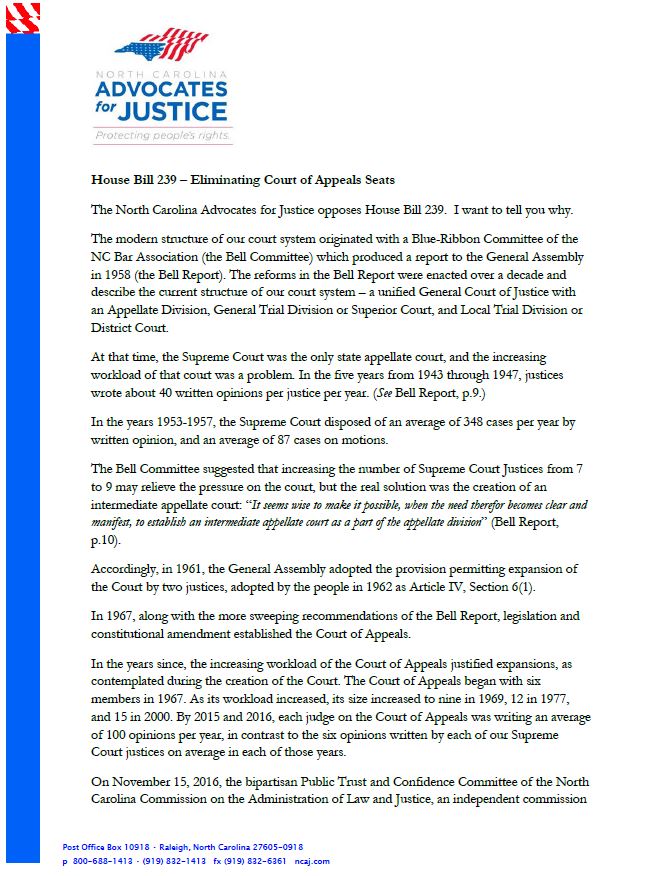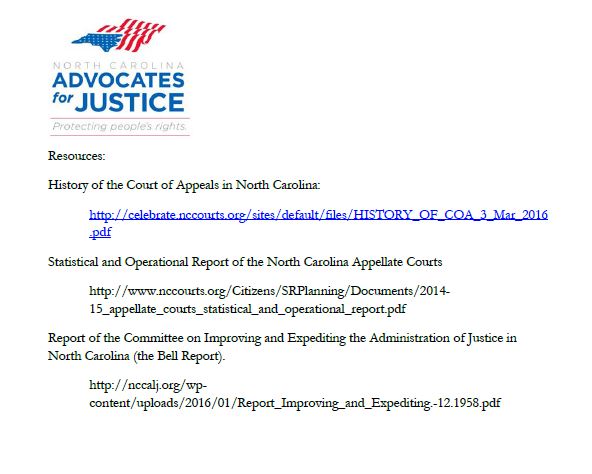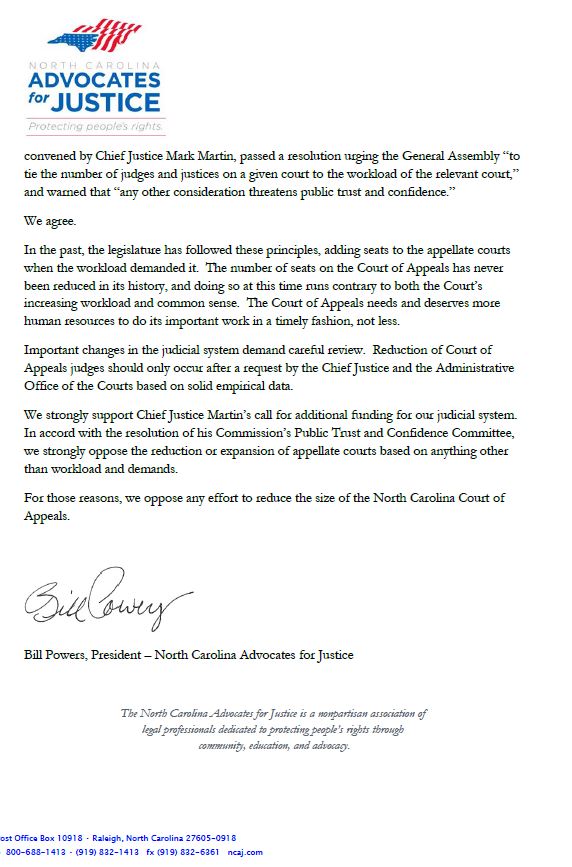
The Court of Appeals needs and deserves more human resources to do its important work in a timely fashion, not less. Important changes in the judicial system demand careful review – Bill Powers, President NCAJ

Reduction of Court of Appeals judges should only occur after a request by the Chief Justice and the Administrative Office of the Courts based on solid empirical data – Bill Powers
Eliminating Court of Appeals Seats in North Carolina
We strongly support Chief Justice Martin’s call for additional funding for our judicial system. In accord with the resolution of his Commission’s Public Trust and Confidence Committee, we strongly oppose the reduction or expansion of appellate courts based on anything other than workload and demands – Bill Powers
See Full Letter from Bill Powers – President NCAJ

House Bill 239 – Eliminating Court of Appeals Seats in North Carolina
The North Carolina Advocates for Justice opposes House Bill 239. I want to tell you why.
The modern structure of our court system originated with a Blue-Ribbon Committee of the NC Bar Association (the Bell Committee) which produced a report to the General Assembly in 1958 (the Bell Report). The reforms in the Bell Report were enacted over a decade and describe the current structure of our court system – a unified General Court of Justice with an Appellate Division, General Trial Division or Superior Court, and Local Trial Division or District Court.
At that time, the Supreme Court was the only state appellate court, and the increasing workload of that court was a problem. In the five years from 1943 through 1947, justices wrote about 40 written opinions per justice per year. (See Bell Report, p.9.) In the years 1953-1957, the Supreme Court disposed of an average of 348 cases per year by written opinion, and an average of 87 cases on motions.
The Bell Committee suggested that increasing the number of Supreme Court Justices from 7 to 9 may relieve the pressure on the court, but the real solution was the creation of an intermediate appellate court: “It seems wise to make it possible, when the need therefor becomes clear and manifest, to establish an intermediate appellate court as a part of the appellate division” (Bell Report, p.10).
Accordingly, in 1961, the General Assembly adopted the provision permitting expansion of the Court by two justices, adopted by the people in 1962 as Article IV, Section 6(1). In 1967, along with the more sweeping recommendations of the Bell Report, legislation and constitutional amendment established the Court of Appeals.
In the years since, the increasing workload of the Court of Appeals justified expansions, as contemplated during the creation of the Court. The Court of Appeals began with six members in 1967. As its workload increased, its size increased to nine in 1969, 12 in 1977, and 15 in 2000. By 2015 and 2016, each judge on the Court of Appeals was writing an average of 100 opinions per year, in contrast to the six opinions written by each of our Supreme Court justices on average in each of those years.
On November 15, 2016, the bipartisan Public Trust and Confidence Committee of the North Carolina Commission on the Administration of Law and Justice, an independent commission convened by Chief Justice Mark Martin, passed a resolution urging the General Assembly “to tie the number of judges and justices on a given court to the workload of the relevant court,” and warned that “any other consideration threatens public trust and confidence.”
We agree.
In the past, the legislature has followed these principles, adding seats to the appellate courts when the workload demanded it. The number of seats on the Court of Appeals has never been reduced in its history, and doing so at this time runs contrary to both the Court’s increasing workload and common sense.
The Court of Appeals needs and deserves more human resources to do its important work in a timely fashion, not less. Important changes in the judicial system demand careful review. Reduction of Court of Appeals judges should only occur after a request by the Chief Justice and the Administrative Office of the Courts based on solid empirical data. We strongly support Chief Justice Martin’s call for additional funding for our judicial system. In accord with the resolution of his Commission’s Public Trust and Confidence Committee, we strongly oppose the reduction or expansion of appellate courts based on anything other than workload and demands.
For those reasons, we oppose any effort to reduce the size of the North Carolina Court of Appeals – Bill Powers, President – North Carolina Advocates for Justice
The North Carolina Advocates for Justice is a nonpartisan association of legal professionals dedicated to protecting people’s rights through community, education, and advocacy.
Post Office Box 10918 • Raleigh, North Carolina 27605-0918 p 800-688-1413 • (919) 832-1413 fx (919) 832-6361 ncaj.com
History of the Court of Appeals in North Carolina:
https://celebrate.nccourts.org/sites/default/files/HISTORY_OF_COA_3_Mar_2016 .pdf
Statistical and Operational Report of the North Carolina Appellate Courts:
Report of the Committee on Improving and Expediting the Administration of Justice in North Carolina (the Bell Report):
https://nccalj.org/wpcontent/uploads/2016/01/Report_Improving_and_Expediting.-12.1958.pdf
 Carolina Criminal Defense & DUI Lawyer Updates
Carolina Criminal Defense & DUI Lawyer Updates